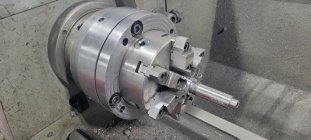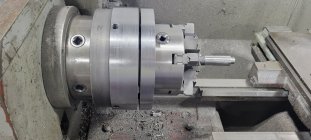I'll post some later this week. I have a mastercam model if anyone with a cnc wants it.Pictures?
Install the app
How to install the app on iOS
Follow along with the video below to see how to install our site as a web app on your home screen.
Note: This feature may not be available in some browsers.
You are using an out of date browser. It may not display this or other websites correctly.
You should upgrade or use an alternative browser.
You should upgrade or use an alternative browser.
True Bore Alignment System
- Thread starter urbanrifleman
- Start date
Jud96
Site $$ Sponsor
How do you find the SSG rods compare to the Grizzly rods? And how close did they get you when you directly checked the lands/grooves?That's a great and fair question. I do want to preface my answer by acknowledging that I have been changing a lot of processes around dialing in, and change often leads to increased time--especially at the front end. I started with tapered range rods and transitioned to a much more repeatable "Grizzly rod." This evolved into using the "Grizzly rod" to get close enough to drill, bore and direct indicate.
My strategy moving forward with the TBAS involves a similar methodology: to achieve preliminary alignment using the TBAS & SSG rod, followed by drilling, boring, and the direct indicating processes to attain final concentricity before proceeding with turning, threading, and reaming.
With that backdrop I am estimating approximately 2 hours +/- 30 minutes of setup and dial-in time before making the first chips prior to using the TBAS.
I do think a meaningful amount of time can be saved now that I can eliminate the shims, the back and forth between the front and rear spiders and the constant verification that nothing moved between dial-in to threading to reaming.
Hopefully that is a reasonable answer.
Hank
In my experience, if you go to the true bore alignment website and read the process as documented for truing the bore with their range rod, I would say that the true bore alignment system rod is [much] faster than the grizzly rod. For reference, I am not a professional and cut less than 20 chambers per year.
Hank
Hank
Jsaum,
Nicely done! Hope it is working out well for you. Many ways to get to the end result. If it works for your situation that's all that matters.
Paul
Larry Koch
Silver $$ Contributor
After read thru this post. My biggest issue is finding long test probes that measure down to .0001... the rest is easy. So were do you guys find these????
Larry Koch
Silver $$ Contributor
Thats my point. All this expensive equipement and nothing to indicate it down to the close to zero. I have been using a .01mm long probe and .0005 long probe. On the short probe .0001 for the crown end work fine.There are no "tenths" reading long-stem DTIs. You take an accuracy hit adding the long probe, but the benefit of being able to get a reading that deep into a bore is worth the trade-off.
Jud96
Site $$ Sponsor
A .0005 long probe?Thats my point. All this expensive equipement and nothing to indicate it down to the close to zero. I have been using a .01mm long probe and .0005 long probe. On the short probe .0001 for the crown end work fine.
Have you actually used an Interapid indicator with the long contact point? It may only have .0005 graduations, but the lines are far apart and can be used to dial in within .0002. Also, the point of the long reach indicators is to dial in the throat or ahead of the throat. Using a short contact point on a .0001 indicator doesn’t do much when you’re only indicating the first 1/4-1/2” of the barrel…
Alex Wheeler
Site $$ Sponsor
Properly used, the .0005 interapid will get you well under a .0001". I know this because I have dialed in a lot of crowns with them and checked them with true .0001 indicators. Thats how you learn how to use the long stem indicator 
Alex Wheeler
Site $$ Sponsor
Cracks me up when I hear its only good to .0005". The speedo on my truck only reads every 10 mph too. I blew up the dial and measured the width of the marks. The black line is .00011" wide. So theres your tenth mark.
Alex Wheeler
Site $$ Sponsor
Jackie brings up a point that you never see talked about. Balance. There was an issue with a very good action got traced back to that problem. When you dial in a part, its not spinning. When you turn the lathe on, if the chuck or part is out of balance things will flex due to centfifical force and your part is no longer dialed in while spinning. Yes this is a real problem. One of the reasons that I have not gone cnc or bought this style of chuck. Theres other reasons but balance is the main one.As a Machinist, I think this system is a good example of a asinine solution to a common problem, that being how to true a barrel for chambering. In particular, in a lathe with a long headstock.
True, it is innovative. But telling people…..”this is great, except due to the excessive overhang and out of balance condition, you might have to spend $20,000 on a lathe upgrade”.
There are many more options in barrel set up that are simple, far less
expensive, and works on the machines that multitudes of Gunsmiths already have.
urbanrifleman
Site $$ Sponsor
And it seems to work really well....
Alex Wheeler
Site $$ Sponsor
The other issue I have is you cant dial at a pivot point. Thats huge for me.And it seems to work really well....
LVLAaron
Gold $$ Contributor
The other issue I have is you cant dial at a pivot point. Thats huge for me.
I hadn't thought about that, but the pivot point is pretty far in. Might be why he sells those special rods.
Alex Wheeler
Site $$ Sponsor
Direct dial at a pivot. And thats all Im going to say...
Larry Koch
Silver $$ Contributor
So you can buy a more than you need Thru bore chuck. And can't get the instruments to dail it in. Mitutoyo did many years ago make a long probe test indicator .0001 but not anymore. I like to set the point of the indicator right where the bullet throat will be cut. And spot check it toward the breech. Understand I'm only interested in two calibers, 6ppc and 30 br. The rest can pound sand.
Last edited:
Similar threads
- Replies
- 2
- Views
- 859
Upgrades & Donations
This Forum's expenses are primarily paid by member contributions. You can upgrade your Forum membership in seconds. Gold and Silver members get unlimited FREE classifieds for one year. Gold members can upload custom avatars.

Click Upgrade Membership Button ABOVE to get Gold or Silver Status.
You can also donate any amount, large or small, with the button below. Include your Forum Name in the PayPal Notes field.
To DONATE by CHECK, or make a recurring donation, CLICK HERE to learn how.

Click Upgrade Membership Button ABOVE to get Gold or Silver Status.
You can also donate any amount, large or small, with the button below. Include your Forum Name in the PayPal Notes field.
To DONATE by CHECK, or make a recurring donation, CLICK HERE to learn how.











